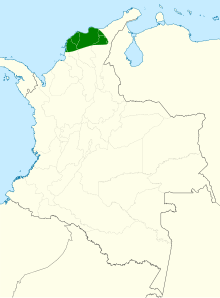|
Turquoise-winged parrotlet
The turquoise-winged parrotlet (Forpus spengeli) is a species of parrot in the family Pscittacidae. DescriptionTurquoise-winged parrotlets are typically 12 centimetres (4.7 in) long and weigh about 28 grams (0.99 oz). Their bodies are mostly yellow-green; eyes are dark brown and legs and beak are light peach. Turquoise-winged parrotlets are sexually dimorphic: males have bright turquoise feathers on their lower backs and rumps, and have purple-blue underwing coverts and axillaries. Females have no blue markings, but their foreheads and faces are brighter yellow-green than males'.[2] Like all parrots, turquoise-winged parrotlets exhibit zygodactyly: two toes face forward and two toes face backward. Distribution and habitatTurquoise-winged parrotlets are found in northern Colombia from the Caribbean coastal region southwest of the Santa Marta Mountains, Atlantico, and south along the Rio Magdalena in Bolívar and Cesar.[2] Turquoise-winged parrotlets are most often found in drier, open or riparian woodlands, cerrado, caatinga, savanna, palm groves, semi-arid scrubland, and pastures.[2] ConservationThere is not an estimate for the number of turquoise-winged parrotlets, but it is believed that their population is decreasing because of increased human interference and habitat destruction.[2] Turquoise-winged parrotlets are listed as Least Concern by the IUCN Red List.[1] Behavior and ecologySocialTurquoise-winged parrotlets are highly gregarious and are often found in flocks of up to 50 birds. ReproductionThe turquoise-winged parrotlet's breeding season is May to August. Females lay 3-7 small white eggs.[2] DietTurquoise-winged parrotlets mostly feed on Cecropia sp. fruits,[3] Mikania sp. and Trema micrantha seeds, and Ambrosia sp. and Marcgravia sp. flowers. They are also known to occasionally feed on other plants such as grass. TaxonomyUntil recently, the turquoise-winged parrotlet was considered a subspecies of the cobalt-rumped parrotlet as Forpus xanthopterygius spengeli. However, in 2015 Bocalini and Silveira studied morphological differences between subspecies of cobalt-rumped parrotlets and determined that the turquoise-winged parrotlet was its own species, F. spengeli.[4] This split was supported by Donegan et al. in 2016.[5] There is continuing debate over the validity of this change. Some taxonomic authorities (including the American Ornithological Society) do not recognize this change in classification.[6] References
|
||||||||||||||||||||||||||||||||||||||
Portal di Ensiklopedia Dunia


